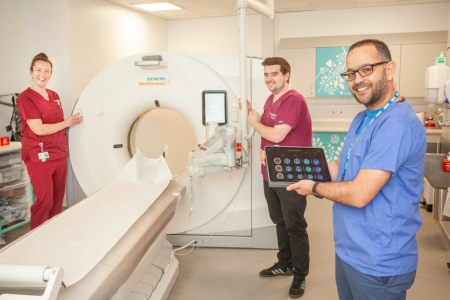
The system, called Rapid CTP, uses artificial intelligence to analyse brain scans in real time, helping specialists to identify which areas of the brain may be saved following a stroke.
As part of Stroke Awareness Month this May, the Trust is highlighting the impact of the technology, which extends the treatment window from four and a half hours to up to 24 – giving more patients the chance to receive life-saving care.
Dr Ahmad Maatouk, Stroke Consultant and Clinical Lead at DBTH, said: “The Rapid CTP software supports our clinical decision-making, offering a clear picture of what’s happening in the brain almost immediately.
“In the right cases, it allows us to confidently extend the treatment window, meaning we can potentially intervene up to 24 hours after the stroke started – giving some patients a second chance at recovery that previously wouldn’t have been possible.”
One of those patients is 59-year-old Suzanne Davies from Denaby, who experienced an ischaemic stroke – caused by a blockage cutting off blood flow to part of her brain.
“Before I had the stroke, I had been getting out of breath easily and my heartbeat was racing” said Suzanne.
“One night, I went to bed exhausted. I woke up in the middle of the night to go to the toilet and suddenly my legs gave way under me. I shouted for my partner, who could tell I was having a stroke – my face was drooping and my speech was slurred.”
Suzanne was rushed to Doncaster Royal Infirmary (DRI), where scans confirmed the stroke.
Thanks to the intervention of skilled health professionals and Rapid CTP software, specialists were able to identify that enough brain tissue remained salvageable, and she received urgent, potentially life-saving treatment.
She was cared for by the specialist Stroke Unit and supported by Dr Dinesh Chadha, Stroke Consultant and a key advocate for the technology.
“I can’t fault the care I received. Everyone was lovely and really tried to lift my spirits,” said Suzanne.
“I felt like an inconvenience at first, but the staff comforted me, made me laugh, and helped me feel at ease.
“My advice to anyone is this: If you think you’re having a stroke, ring an ambulance immediately. It can escalate very quickly – you wouldn’t hesitate to call for a loved one, so do it for yourself if you can.”
Suzanne has since returned home and continues her recovery under the care of community nurses.
The introduction of Rapid CTP is part of a wider programme of improvements to stroke care at DBTH. As of April 2024, thanks to an enhanced partnership with Sheffield Teaching Hospitals, the Trust’s thrombectomy service – used to physically remove clots in certain types of stroke – is now available seven days a week, helping to ensure more patients can access urgent, specialist treatment when they need it most.
Dr Nick Mallaband, Acting Executive Medical Director said: “Over the past 12 months, Rapid CTP has made a real difference to how we diagnose and treat stroke, helping our teams deliver faster, more accurate care.
“Crucially, it doesn’t replace clinical expertise – it enhances it. The software gives our stroke specialists immediate insights that help them make confident, informed decisions when every second counts.
“It’s a brilliant example of how human skill and technology can work hand-in-hand to improve patient outcomes. As we prepare to launch our refreshed Healthier Together organisational strategy, with a focus on becoming a digitally enabled and mature organisation, this is exactly the kind of progress we want to build on.”
The Trust is sharing Suzanne’s story as part of Stroke Awareness Month to raise understanding of stroke symptoms and the importance of seeking help without delay. The main signs of a stroke can be remembered with the acronym FAST:
Face – has it dropped on one side?
Arms – can they lift both and keep them there?
Speech – is it slurred, garbled, or absent?
Time – if you spot any of these signs, it’s time to call 999.
Please note, symptoms can vary from person to person. If you suspect a stroke, seek emergency help immediately.